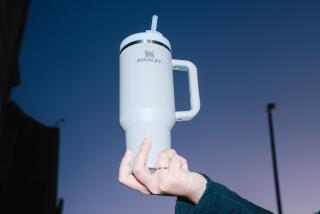Got Soda? Why Kids Drink Less Milk
- Share via
When I was a kid, we drank milk at each meal and sometimes in between. Soda pop or Kool-Aid was special, reserved for picnics and parties. Soft drinks came in 6.5-ounce glass bottles--just enough for a treat. There were no humongous 64-ounce containers with zillions of empty calories.
It’s different with my daughter’s generation. Twenty-five years ago, teenagers drank nearly twice as much milk as soda. Now they drink twice as much soda as milk. Today’s teens don’t picture themselves as little old ladies and little old men hunched over walkers.
But by avoiding milk, perhaps the richest source of calcium in the American diet, they are setting themselves up for osteoporosis and bone fractures long before that disease would otherwise show up. It’s a public health problem in the making.
A panel of experts convened by the National Institutes of Health concluded that nine out of 10 girls and three out of four boys ages 9 to 17 do not get enough calcium. Nor do they get enough vitamin D that helps them absorb what little calcium does creep into their diets. “It will be an epidemic when 90% of the girls develop fractures in their 50s, 60s and 70s rather than their 80s and 90s,” says Dr. William Russell, a pediatric endocrinologist at Vanderbilt University Medical Center and a member of the NIH panel.
Unlike most epidemics, however, this one is largely preventable. For now, though, money and marketing are triumphing over public health.
Former Coca-Cola Chairman Douglas Ivester, told shareholders in the company’s 1997 annual report that the firm’s goal was to “make Coca-Cola the preferred drink for any occasion, whether it’s a simple family supper or a formal state dinner.” The company, Ivester also said, is “putting ice-cold Coca-Cola Classic and our other brands within reach, wherever you look: at the supermarket, the video store, the soccer field, the gas station--everywhere.”
The United States already spends about $14 billion to treat osteoporosis--a cost that is likely to soar if the Pepsi generation and its children continue to consume ever-increasing amounts of soft drinks. But osteoporosis isn’t the only illness with a link to a poor diet and nutrition. The empty calories in soft drinks contribute to obesity in children, and obesity rates among children ages 6 to 19 have doubled in the last 20 years. Obesity often signals cardiovascular disease and diabetes down the road. During the last 30 years, the marketing machines of the soft drink industry have pumped billions into flashy advertising campaigns to get kids to drink their beverages instead of such alternatives as water, fruit juice and, of course, milk. The industry has reached deep into the schools, targeting financially strapped districts with “pouring rights” contracts--exclusive deals to serve and promote one company’s brand. In return, schools get money for band uniforms, books, scoreboards and other items that they may have trouble covering out of their normal budgets.
An example is San Benito High School in Hollister, Calif., a 2,800-student facility that struck a deal with Pepsi to supply drinks and bottled water for the school’s four snack bars and three food carts. Food service manager Sybil McConnell won’t say how lucrative the five-year contract is, but notes that milk is the students’ last beverage choice.
Schools that make deals with soft drink companies to pay for students’ educational needs are in a difficult ethical position, says Barry Sackin, a vice president at the American School Food Service Assn., a professional group. “It’s the funding demands of schools today versus the long-term costs of health and productivity,” Sackin says.
School officials have argued in the past that students are going to drink soft drinks anyway, often because their parents let them, so why not bow to the inevitable and bring in some extra money?
Harry Potter, the enchanting character in the wildly popular series of books by J.K. Rowling, is the next target. Coca-Cola his spending $150 million to exclusively sponsor the upcoming movie, “Harry Potter and the Sorcerer’s Stone..” That sum also includes fees to Warner Bros., the maker of the movie, as well as advertising, packaging and reading programs. Harry Potter and Coca-Cola will be linked in all kinds of promotions, including a Christmas sweepstakes for schools.,
The Center for Science in the Public Interest and several other consumer and health organizations have begun a campaign to “save” Harry. Through a Web site, https://www.saveharry.com, the groups are encouraging people to send e-mails to Rowling, urging her to scrap her deal with Coke. The center is also trying to persuade local communities to get soft drinks out of the schools and promote better nutrition. Michael Jacobson, the center’s director, knows he and the other groups are swimming upstream.
“Our effort is so tiny compared to the marketing behemoth that reaches out everywhere and every which way,” he says.
The dairy industry has not been standing still. It has spent about $180 million during the last few years to promote milk and other dairy products. “It’s essential people see milk as very cool,” says Kurt Graetzer, chief executive of the National Fluid Milk Processor Promotion Board.
So, the industry is attempting to spruce up milk’s image by creating flavored milks and using celebrities and star athletes to carry its message.
What remains to be seen is whether Britney Spears sporting a milk mustache will get kids to change their habits, especially when the same star may advertise milk one day and soda the next.
All the strawberry milk in the world won’t help unless parents take some responsibility for their children’s health by watching what their kids consume. And milk should be available in appropriately sized containers at schools, vending machines, sporting events, stores and restaurants.
Arriving at Union Station in Washington, D.C., recently, I wanted milk for breakfast. I thought I might find it at a McDonald’s restaurant. “We have no more [milk],” the counter clerk replied.
“But you never run out of Coke?” I asked.
“Never,” she said..
*
Send comments to: trudyal530@aol.com. Health Matters appears on the third Monday of the month.
More to Read
Eat your way across L.A.
Get our weekly Tasting Notes newsletter for reviews, news and more.
You may occasionally receive promotional content from the Los Angeles Times.










